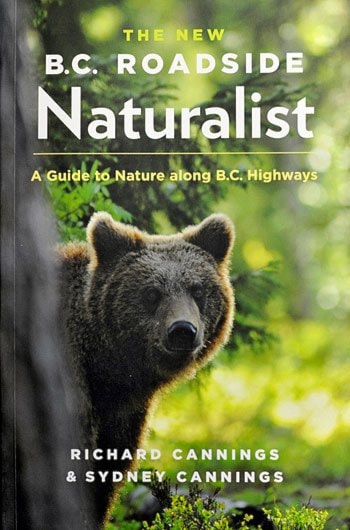“If you stop to take a breath, you will smell the fragrance of subalpine fir and, if you look carefully, you will actually see a few young firs growing slowly in the shade of the pines, patiently waiting for their time in the sun.”
- Rest Stop, Rancheria Falls
That, right there, that is what makes The New B.C. Roadside Naturalist a different kind of read than what you would get from a kilometre-by-kilometre treatment of the Alaska Highway.
This new book tells a story of each section of the highway, using the English language in an unabashedly eloquent and fun way.
“No, we had no formal training in writing,” says Syd Cannings, the co-author who is responsible for the Yukon addition to the book.
“My older brother (Rob), who is a fantastic writer, schooled us well and I learned how to write concisely and clearly.”
When he says “us,” he means his identical twin brother, Richard, who teamed up with Cannings 11 years ago to write the first, Yukonless, B.C. Roadside Naturalist.
Both books were written to tell the stories of what drivers and passengers can expect to see out their windows as they drive B.C., and now Yukon, highways.
“I like to write that way,” says Cannings. “I think most people like to read a story; it has more impact that way.
“As the driver, you set the book out at breakfast in the morning and you read that portion of the chapter before you go.
“You then have something in mind and you don’t have to keep track of every kilometre.”
So, at the rest stop at Rancheria Falls, the traveller knows the spruce-pine forest grew following a fire a little more than 100 years ago, and the forest floor is covered in those “boreal stalwarts” of bunchberry, crowberry, lingonberry and Labrador tea.
The Cannings then suggest that although the wheelchair-accessible falls are “undeniably beautiful,” it is the geological story underfoot that is really fascinating: you can walk over the Cassiar Fault, here, where a collision of the westward-moving North America and northward-moving Pacific plate shifted the very land 50 to 100 kilometres away.
The fault “reveals itself” as a 50-metre-wide deformation of granite that shows a “stretched, crystalline fabric” that tells you the active fault was shearing as it was cooling.
This, the Cannings tell the readers, is “the edge of North America.”
Who knew?
It’s an interesting story that Cannings says was told using as little “scientific jargon” as possible. But, when scientific jargon is necessary, it is explained in their conversational style.
For example, at the highest point of the Alaska Highway, at the pass between the watersheds of the Muskwa and Toad Rivers, the traveller will see hoodoos. These are described as “erosional features that are created where the soft sediments on a hillside are almost entirely washed away, but those protected by a cap of rocks or more resistant sediments remain.”
Later on, they use the word “community” to describe the ecosystem of the Takhini Salt Flats.
“To be honest,” says Cannings, “that is a scientific term.
“Botanists use the word ‘community’ in a very specific sense.
“I know it has other meanings and connotations of living together and working together, but I did use it as a scientific word.”
Speaking of science, Cannings uses it as a defence when he declares that Snag, Yukon was not the coldest spot in North America.
“Snag is still officially the coldest place in North America,” he says quickly. “I’m a biologist, so I can’t comment exactly on why.
“Temperatures were taken by thermistors and probes, but it did not have an official weather station at the time.”
This particular “blasphemy,” on Page 261, is said to have occurred at Mill Creek, British Columbia, on Jan. 7, 1982. It was a calm, clear night when the intensely cold air drifted into the deep valley (which is what happens occasionally to Mary Lake, causing it to be 10 degrees colder than the rest of Whitehorse).
The temperature hit -71 degrees Celsius, a full eight degrees colder than Snag’s record.
As a biologist working on endangered species for Environment Canada in Whitehorse, Syd Cannings would take the time to drive south whenever needed. He would use a recorder to collect his thoughts on what he saw.
When he saw something interesting about, say, geology, he would call up his geologist friends and ask them to explain it to him.
Perhaps it wasn’t interesting, but they would tell him if there was something else that he missed in that area.
Once he got over the occasional writer’s block, he would “blurt it all out until I got tired of it.” Then he would email it to his brother down south, who is a consulting biologist who assesses endangered species and organizes broad-scale bird population surveys.
“He would have a fresh look at it and vice versa.”
If it is any indication, his biologist friends have been buying their new book “like hot cakes.”
“It is a biased sample,” says Cannings with a laugh.
Another test will be today at noon, when Cannings will sign books at Mac’s Fireweed Books in Whitehorse.
Darrell Hookey is a freelance writer living in Whitehorse.
